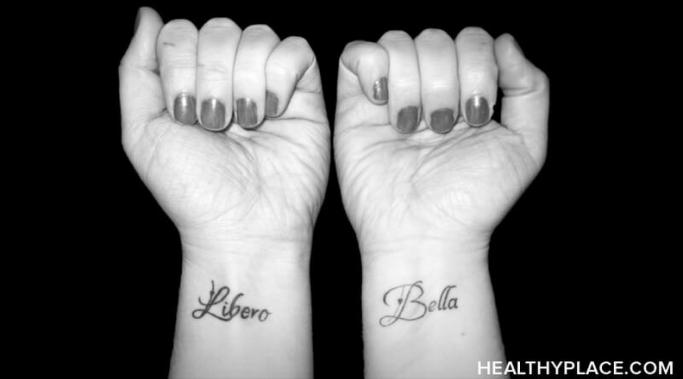There are ways to explain self-harm scars to children, but I haven't always known what to say. When I was in my first year of college I had a job working with children at a daycare. Children are curious by nature and they ask a lot of questions about their surroundings. If something is “out of the norm” they are going to ask questions about it. One night, I wore a dress which showed a few of my scars. I had a small child come up and ask me, “Teacher, what happened to your leg?”
Self-Injury Scars
The workplace can be a stressful and triggering environment for self-harmers. First, we have to make the decision of hiding our scars or not. If we don't, we face questions, scrutiny, and gossip from our coworkers and bosses. Secondly, we may, and probably will, be triggered to self-harm at some point. We can't control what others say and do, or what is asked of us while we're working. Thus, it is essential for us to find ways to minimize stress and stay on the course of recovery from self-harm in a triggering environment like the workplace.
Reminiscing without self-harm can be hard but you can make memories without scars. With the social media today, practically every step you take is recorded. Whether you are tagged in photographs from the night before or you tweet about the meal you had, life is not a secret anymore. Technology has made it so you cannot forget some of the memories from your past because, well, they may show up on an app or in an online journal or blog you forgot about. Sometimes the most difficult memories are the ones that crush you without warning and reminiscing about these memories can cause self-harm.
Not hiding self-harm scars can be a tough decision. When someone sees a self-harm scar and brings it up, panic often takes over the body and mind of the person who self-harms. Battling the embarrassment that comes with someone questioning a visible scar from self-harm can often bring forward many negative emotions and anxiety. From there, the battle becomes you fighting against your own insecurities. But not hiding self-harm scars is an option.
When you are struggling with self-harm, it is very rare that when someone asks about a visible cut or burn, you will answer with the truth. There are the occasional few who will honestly answer that question and admit to their struggle without embarrassment or insecurity. While that kind of behavior does occur once in a while, more times than not people who self-harm use cover stories for self-harm scars.
In the realm of reality television and social media, people on shows about plastic surgery and ways to change your body have become royalty. People have a genuine interest in following the lives of absolute strangers just to imagine how it would feel to have their skin sculpted into anything they wish. You’ve seen shows and read articles about people getting surgery to look like Barbie dolls or celebrities. Not only is it frightening to get that much surgery, it is sad that people don’t feel comfortable enough in their own skin and appreciate who they are.
I’ve stated many times how helpful books can be when overcoming self-harm. There have been numerous books I have discussed that helped me when I was struggling to understand my own addiction to cutting. In a world where self-harm is seen by many as taboo, it is good to fall into a story where the topic is relatable and real.
When someone has a bad hair day (as cliché as it sounds), they tend to go for the same hat or hairstyle to find a sense of comfort. Even when finding a seat in classroom or a stall in a bathroom, people tend choose what they are comfortable with and those decisions become almost habitual. The same goes for self-harmers when they feel triggered to hurt their bodies – they make choices based on what they know best.
This also goes hand-in-hand with what is used to cover up self-harm scars. Those who feel the need to cover up self-injury marks typically go for the same kind of solution – bracelets, make-up, long sleeves, etc. Everyone makes certain decisions to protect themselves from feeling a certain way or turning to certain behaviors.
When someone who self-harms makes a mark, they do it for a reason unlike anyone else’s. No one person talks or sees or thinks the same and, in truth, that is quite a positive thing. However, when it comes to negative thoughts and choices, those too are specific to that person and that person alone can only change it.
Every self-harm scar and mark is proof of hardship, but is also proof of survival. The scars should also tell the self-harmer that it is possible to move forward after the mark is made. Sometimes, it is important to stand back, look in the mirror and really see the scars scattered on your skin. Think about why they are there and if you could have stopped yourself from making them.
I woke up and automatically started putting on my bracelets before I realized what I’d promised myself I would do. At first, as I started taking them off, I thought maybe I wouldn’t partake in this experiment. However, I knew that if I didn’t at least try to make it through the day with nothing on my wrists, I’d feel as if I’d disappointed myself.
So, I took the bracelets off.
I did not like how it felt wearing nothing on my self-harm scars on my wrists. First of all, I realized how awful my tan lines were from wearing them on a daily basis. That, at least, made me laugh away some anxiety. I felt as though I was naked and that I needed to hide myself before my self-injury scars were noticed. In truth, it was only a big deal to me. But the big deal did make me feel uncomfortable throughout day.









